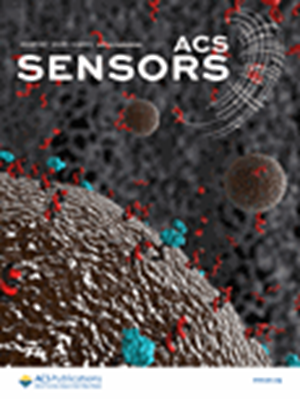Aptamer-Based Electrochemical Biosensing Platform for Analysis of Cardiac Biomarkers
IF 8.2
1区 化学
Q1 CHEMISTRY, ANALYTICAL
引用次数: 0
Abstract
Monitoring biomarkers secreted by cardiomyocytes is critical to evaluate anticancer drug-induced myocardial injury (MI). Cardiac troponin I (cTnI) is considered the gold standard biomarker for MI. Herein, an electrochemical aptasensor is engineered for cTnI detection based on lanthanide europium metal–organic frameworks (Eu-MOFs) and a hybridization chain reaction-directed DNAzyme strategy. Three types of Eu-MOF morphologies were easily synthesized by changing the solvent, and the Eu-MOF modulated by mixing the solvent of dimethylformamide and H2O (D-Eu-MOF) exhibited the best performance compared to other morphologies of the Eu-MOFs. Multifunctional nanoprobes were constructed from D-Eu-MOF@Pt loaded with natural horseradish peroxidase and combined with an aptamer-initiated nuclear acid hybridization chain reaction to form G-quadruplex/hemin DNAzymes for signal amplification. A novel capture probe is constructed on the basis of DNA nanotetrahedrons modified on screen-printed gold electrodes to enhance the capture of the target and multifunctional nanoprobes for signal amplification. It exhibits a detection limit of 0.17 pg mL–1 and a linear range from 0.5 pg mL–1 to 15 ng mL–1. The practicality of the platform is evaluated by measuring cTnI in real samples and secreted by cardiomyocytes after drug treatment, which provides great potential in drug-induced MI evaluation for clinical application.

用于分析心脏生物标记物的基于色素的电化学生物传感平台
监测心肌细胞分泌的生物标志物对于评估抗癌药物诱发的心肌损伤(MI)至关重要。心肌肌钙蛋白 I(cTnI)被认为是心肌梗死的金标准生物标志物。本文基于镧系元素铕金属有机框架(Eu-MOFs)和杂交链反应引导的 DNA 酶策略,设计了一种用于检测 cTnI 的电化学传感器。与其他形态的 Eu-MOF 相比,二甲基甲酰胺和 H2O 混合溶剂调制的 Eu-MOF(D-Eu-MOF)表现出最佳性能。由装载天然辣根过氧化物酶的 D-Eu-MOF@Pt 构建了多功能纳米探针,并将其与适配体引发的核酸杂交链反应相结合,形成用于信号放大的 G-四链/hemin DNA 酶。一种新型捕获探针是在丝网印刷金电极上修饰的 DNA 纳米四面体的基础上构建的,以增强对目标的捕获,并利用多功能纳米探针进行信号放大。其检测限为 0.17 pg mL-1,线性范围为 0.5 pg mL-1 至 15 ng mL-1。通过测量真实样本中的 cTnI 和药物治疗后心肌细胞分泌的 cTnI,评估了该平台的实用性,为药物诱导的心肌缺血评估提供了巨大的临床应用潜力。
本文章由计算机程序翻译,如有差异,请以英文原文为准。
求助全文
约1分钟内获得全文
求助全文
来源期刊

ACS Sensors
Chemical Engineering-Bioengineering
CiteScore
14.50
自引率
3.40%
发文量
372
期刊介绍:
ACS Sensors is a peer-reviewed research journal that focuses on the dissemination of new and original knowledge in the field of sensor science, particularly those that selectively sense chemical or biological species or processes. The journal covers a broad range of topics, including but not limited to biosensors, chemical sensors, gas sensors, intracellular sensors, single molecule sensors, cell chips, and microfluidic devices. It aims to publish articles that address conceptual advances in sensing technology applicable to various types of analytes or application papers that report on the use of existing sensing concepts in new ways or for new analytes.
文献相关原料
公司名称
产品信息
阿拉丁
DOX hydrochloride
 求助内容:
求助内容: 应助结果提醒方式:
应助结果提醒方式:


